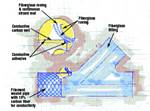Composite Pipe Valves Offer Corrosion-Free Performance
Composite valves and actuators have gained entry into offshore facilities, as well. At about one-third the weight of steel, fiber-reinforced composite flow control components are a welcome addition to piping systems and increasingly in demand for marine environments as a high-strength, corrosion-resistant alte
Share
Read Next
Composite valves and actuators have gained entry into offshore facilities, as well. At about one-third the weight of steel, fiber-reinforced composite flow control components are a welcome addition to piping systems and increasingly in demand for marine environments as a high-strength, corrosion-resistant alternative to steel or injection-molded plastics. Composite valves were originally developed for the highly aggressive environments found in the chemical processing industry. The first composite valves were made using Ryton, a polyphenylene sulfide (PPS) resin supplied by CPChem (Houston, Texas, U.S.A.) and reinforced with carbon fiber. High-performance, highly corrosion-resistant engineered thermoplastic like PPS and polysulfone (PSU) matrices are still used for products subjected to severely corrosive service, such as pipes that handle hot, concentrated sulfuric acid and organic solvents.
Nil-Cor Operations of Dresser Flow Control (Alliance, Ohio, U.S.A.) manufactures composite ball valves, butterfly valves, check valves and actuators. For most offshore applications, Nil-Cor recommends fiberglass/vinyl ester as a material that maintains its strength and creep resistance at service temperatures from –50°F to 210°F/-58°C to 100°C and at pressures up to 275 psig/19 bar, at lower cost. So far, Nil-Cor’s offshore history has been in simple block valves and actuators for non-pressurized service in locations where neither fire nor conductivity ratings are required. These are straightforward mechanical devices that open valves to let piped gases or liquid flow. Nil-Cor is now pursuing the offshore market for pressurized service, with the goal of providing pressure valves that have the same capability as equivalent FRP pressure piping, so wherever that piping can go, the valves can go, as well.
The company’s composite ball valves have been installed on seawater cooling pipelines on Mars (1995) and Shell’s URSA TLP (1999), among other offshore platforms in the Gulf of Mexico. They have also been specified for the Petrobras Barracuda Floating Production Storage and Offloading (FPSO) vessel project in Brazil, for use in sodium hypochlorite (NaOCl) injection systems to kill marine organisms in platform cooling water systems. The Barracuda is currently under construction by Halliburton.
No material or combination of materials has the answer to all the problems faced in the rugged offshore/marine environment, says McDermott’s Landry — there are advantages and limitations to all groups. “Disadvantages of FRP are impact resistance, initial cost of material vs. carbon steel and some reluctance on the part of regulatory agencies. On the other hand, composites offer corrosion resistance, light weight, ease of installation, no maintenance and long service life.”
Related Content
-
First Airbus A350 crash confirmed in Haneda
Shortly after touch-down, a JAL A350-900 aircraft recently collided with a De Havilland Canada Dash 8. Exact circumstances are still unknown.
-
Plant tour: Aernnova Composites, Toledo and Illescas, Spain
RTM and ATL/AFP high-rate production sites feature this composites and engineering leader’s continued push for excellence and innovation for future airframes.
-
Hybrid process marries continuous, discontinuous composites design
9T Labs and Purdue applied Additive Fusion Technology to engineer a performance- and cost-competitive aircraft bin pin bracket made from compression-molded continuous and discontinuous CFRTP.

